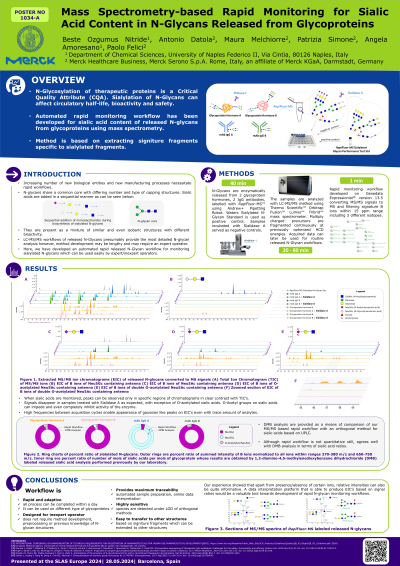Frontiers in Technology
Poster Session A
(1034-A) Mass Spectrometry-based Rapid Monitoring for Sialic Acid Content in N-Glycans Released from Glycoproteins
Tuesday, May 28, 2024
16:30 - 17:15 CEST
Location: Exhibit Hall

.jpg)
Beste Ozgumus Nitride
Ph.D. Candidate
Department of Chemical Sciences, University of Naples Federico II, Via Cintia, 80126 Naples, Italy
Naples, Campania, Italy
Poster Presenter(s)
Abstract: Glycosylation of biotheraupetics is a critical quality attribute that has to be monitored very carefully. Increasing number of new biological entities and new manufacturing processes make it necessary to develop rapid workflows without compromising from sensitivity. LC-MS/MS workflows of released N-Glycans presumably provide the most detailed N-glycan profile analysis of glycoproteins however, method development may be lengthy and may require an expert operator. We have developed a rapid released N-Glycan workflow for monitoring sialylated N-glycans. N-glycans have been enzymatically released in reducing conditions and labeled with fluorescent label RapiFluor-MS. Andrew+ pipetting robot has been used to reduce hands-on time and maximize traceability. Released N-glycans were analyzed with an Orbitrap Fusion Tribrid mass spectrometer and data has been interpreted on Genedata Expressionist platform without preprocessing. Two glycoprotein hormones expressed in Chinese Hamster Ovary (CHO) cells and two IgG-based drugs, one expressed in CHO cells and other expressed in murine myeloma SP2/0 cells, were selected for this study. Monosaccharic and trisaccharic B fragments have been used to extract chromatograms from MS/MS signals for N-Glycolylneuraminic; N-Acetylneuraminic acid with or without O-acetyl modification. Bovine fetuine was used as a positive control. Signals arising from signature fragments have been disappeared upon incubation with Sialidase A. With this simplified workflow, sialylated N-glycans have been monitored successfully using signature fragments even at trace levels. Presence of sialic acids is in accordance with the positive control and orthogonal analysis previously performed by our group. Furthermore, we demonstrate, a greater sensitivity is reached. Despite being a qualitative method, relative signal intensities can be indicative of extent of sialylation. Since the method is based on MS/MS fragments, presence of isomers or coelution does not present a challenge as is usually the case with FLR-LC-MS workflows. This simplified workflow does not require neither time-consuming preprocessing steps of data interpretation nor a previous knowledge of glycosylation, therefore, can be used by an inexpert operator. Rapid monitoring approach can be easily extended to other N-Glycan structures on condition that more flexible data analysis tools are developed. An example of this is given by an N-glycan containing α-galactose to highlight the potential of the workflow and reflect the needs of different glycoprotein characterization tools.
